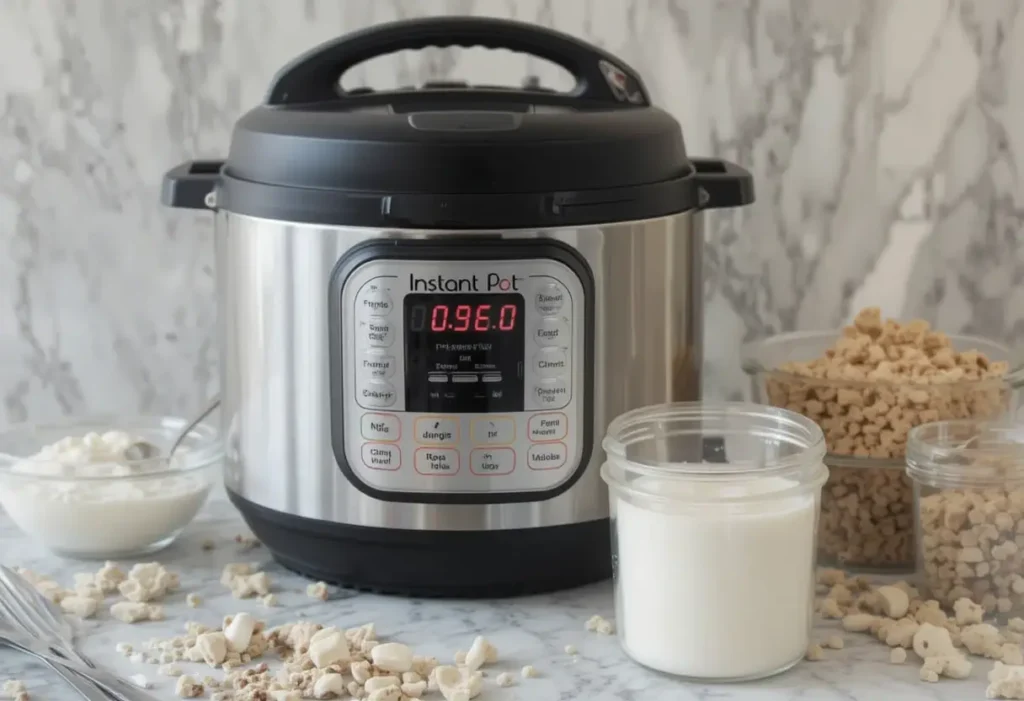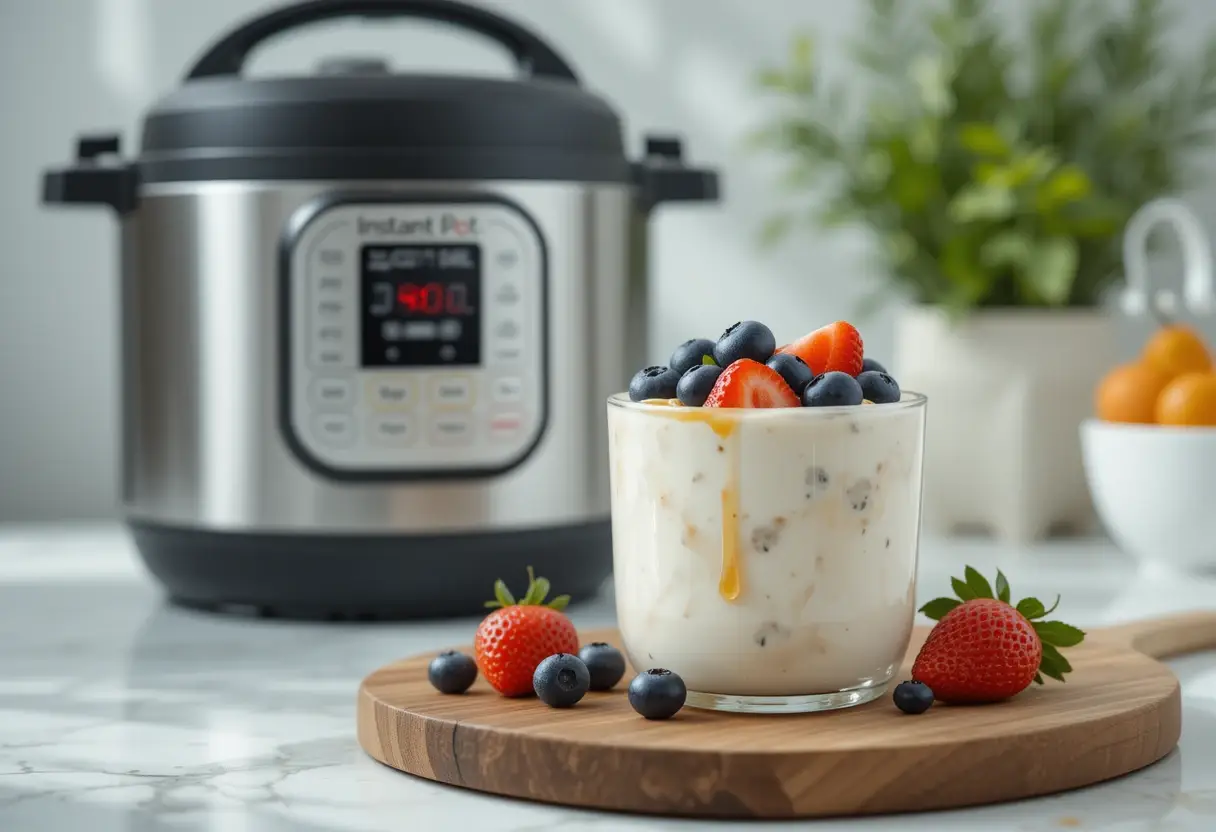The Instant Pot has revolutionized home cooking, making even traditionally time-consuming recipes easier and faster. Among its versatile functions, the ability to make yogurt stands out as both surprising and delightful. With a bit of patience and the right technique, you can create creamy, delicious, and healthy yogurt right in your own kitchen. But what makes this method so unique and worth trying?

What Makes Instant Pot Yogurt Unique?
Unlike traditional stovetop yogurt-making methods, the Instant Pot simplifies the process by offering precise temperature control. This ensures optimal conditions for fermentation, eliminating the need for constant monitoring. With its built-in “Yogurt” function, the Instant Pot takes the guesswork out of achieving the right consistency and flavor.
Another feature that makes the Instant Pot method unique is its consistency. By maintaining steady heat, the appliance fosters the growth of beneficial bacteria that transform milk into yogurt. The result? A creamy, rich texture every single time, without the risk of scorching or uneven results.
Furthermore, this method allows you to customize your yogurt to your liking—whether you prefer it tangy or mild, thick like Greek yogurt, or smooth and pourable.
Table of Contents
Benefits of Homemade Yogurt
Making yogurt at home with an Instant Pot offers several advantages over store-bought varieties:
- Healthier Ingredients: Homemade yogurt gives you full control over what goes into it. You can avoid added sugars, preservatives, and artificial flavors, creating a healthier option for you and your family.
- Cost-Effective: A few simple ingredients—milk and a yogurt starter—are all you need to make batches of fresh yogurt. Over time, this can save money compared to buying individual yogurt containers.
- Customizable Flavor and Texture: Homemade yogurt allows you to experiment with flavors, add-ins, and thickness. Whether you prefer fruit-infused yogurt, honey drizzles, or plain and tangy, the choice is yours.
- Sustainability: Making yogurt at home reduces plastic waste from store-bought yogurt containers. By storing your yogurt in reusable jars or containers, you take a step toward a more eco-friendly lifestyle.
- Freshness Guaranteed: There’s nothing quite like the taste of fresh yogurt made from scratch. You know it’s free from unwanted additives and has been made under your care and attention.
The Instant Pot simplifies the yogurt-making journey, turning what might seem like a daunting culinary task into a straightforward and enjoyable process. With a little practice, you’ll soon be whipping up batches of creamy yogurt that rival even the best store-bought brands!
Essential Ingredients for Instant Pot Yogurt
To create the perfect batch of Instant Pot yogurt, it’s important to start with the right ingredients. Each component plays a crucial role in determining the texture, flavor, and quality of the final product. Here’s a breakdown of what you need and how to make the best choices.
Choosing the Right Type of Milk
The foundation of any yogurt is milk, so selecting the right type is key. Here are some considerations:
- Type of Milk:
- Whole Milk: Produces the creamiest, richest yogurt with a full-bodied texture.
- 2% Milk: Offers a lighter option while still maintaining good consistency.
- Skim Milk: Creates a thinner yogurt unless you add thickeners like powdered milk.
- Pasteurization:
- Ultra-Pasteurized Milk: Often preferred because it requires less preparation, as it’s already heated to high temperatures.
- Regular Pasteurized Milk: Works well, but may require additional boiling to kill any unwanted bacteria.
- Non-Dairy Alternatives:
- For those avoiding dairy, options like almond, soy, or coconut milk can be used. Be sure to choose varieties free of additives that may interfere with fermentation, and consider adding a thickener like agar-agar for better consistency.
- Freshness:
- Always use fresh milk to ensure optimal results and a longer shelf life for your yogurt.
Importance of Yogurt Starters
A yogurt starter is the catalyst that transforms milk into yogurt by introducing live, active cultures. These friendly bacteria ferment the milk, resulting in the tangy and creamy product we love.
- Store-Bought Yogurt:
- Choose plain, unflavored yogurt labeled with “live and active cultures.” This can serve as your starter if it contains the necessary probiotics.
- Powdered Starters:
- Available in specialty stores or online, powdered starters are convenient and consistent. They’re an excellent choice for those looking for a dependable result.
- Homemade Yogurt:
- If you’ve made yogurt before, you can use a small portion of your previous batch as a starter. This helps maintain a continuous cycle of fresh yogurt.
- Quantity:
- Use about 2-3 tablespoons of starter per quart of milk for the best results.
Optional Additives for Enhanced Flavor
While plain yogurt is delicious on its own, you can customize it to suit your taste preferences with optional additives:
- Sweeteners:
- Honey, maple syrup, or agave can be added for natural sweetness.
- Avoid adding sweeteners before fermentation, as they can disrupt bacterial growth.
- Flavorings:
- Vanilla extract, almond extract, or spices like cinnamon can enhance the flavor profile.
- Mix these in after the yogurt has set.
- Thickeners:
- For thicker yogurt, consider adding powdered milk, gelatin, or agar-agar to the milk before fermentation.
- Fruits and Purees:
- Fresh fruits, fruit purees, or jams can be swirled in after fermentation for a burst of flavor.
By carefully selecting your ingredients and understanding their roles, you can create a customized yogurt that suits your tastes and dietary needs, making the Instant Pot yogurt-making process truly your own.
Step-by-Step Guide to Making Yogurt in an Instant Pot
Making yogurt in an Instant Pot is a straightforward process that becomes second nature with a little practice. Follow this detailed step-by-step guide to ensure consistent, creamy results every time.
Preparing Your Instant Pot
Before starting, it’s crucial to prepare your Instant Pot properly to create the perfect environment for fermentation.
- Cleanliness Is Key:
- Ensure your Instant Pot, inner pot, and all utensils are thoroughly cleaned and sanitized. This helps avoid introducing unwanted bacteria that could affect the fermentation process.
- Assemble Your Tools:
- Gather the inner pot, lid (with or without a sealing ring), and any additional tools like a whisk or thermometer. Using a clean, dry dish towel nearby is also helpful.
- Check the Instant Pot Settings:
- Verify that your Instant Pot has a “Yogurt” function, as this feature is essential for regulating the temperature needed for fermentation.
- Test the Inner Pot:
- Fill the inner pot with water and run a quick test to ensure it’s working correctly. This step isn’t always necessary, but it’s helpful if you’re using the appliance for the first time.
Mixing Ingredients: A Detailed Walkthrough
The mixing phase is where you combine your milk and starter culture to begin the yogurt-making process.
- Heat the Milk:
- Pour your milk into the Instant Pot and select the “Yogurt” or “Boil” function to heat it to 180°F (82°C). This step helps kill any unwanted bacteria and ensures a stable base for fermentation.
- Use a kitchen thermometer to monitor the temperature for accuracy.
- Cool the Milk:
- Once the milk reaches the desired temperature, remove the inner pot or let it cool within the Instant Pot. Stir occasionally to speed up the cooling process until it reaches 110°F (43°C).
- Add the Yogurt Starter:
- Take 2-3 tablespoons of your chosen yogurt starter (store-bought or from a previous batch) and mix it with a small amount of the cooled milk in a separate bowl. Whisk until smooth.
- Gradually whisk the mixture back into the main batch of milk to evenly distribute the cultures.
- Optional Additives:
- If desired, incorporate thickeners like powdered milk or sweeteners at this stage. Mix well to avoid lumps.
Setting the Instant Pot: Time and Temperature Factors
The final step involves setting your Instant Pot to create the perfect environment for fermentation.
- Set the Yogurt Function:
- Press the “Yogurt” button and adjust the time to 8-12 hours, depending on how tangy you want your yogurt. Longer times result in tangier yogurt, while shorter times produce a milder flavor.
- Cover and Secure:
- Cover the Instant Pot with the lid. You can use the regular lid or a glass lid if your Instant Pot supports it. The sealing ring isn’t necessary for yogurt-making.
- Monitor the Process:
- The Instant Pot will maintain a consistent temperature of approximately 110°F (43°C), perfect for fermentation. Check occasionally, but avoid disturbing the process too much.
- Test for Doneness:
- After the set time, open the lid and check the consistency. The yogurt should have thickened and set. If it’s still too runny, you can extend the fermentation by another hour or two.
- Chill the Yogurt:
- Transfer the inner pot to the refrigerator and chill the yogurt for 4-6 hours. This helps firm up the texture and develop the flavor.
By following these steps, you can confidently make homemade yogurt that’s creamy, delicious, and customized to your taste, all with the convenience of your Instant Pot!
Troubleshooting Common Instant Pot Yogurt Issues
Why Is My Yogurt Runny?
Runny yogurt is a common issue, often caused by one of the following factors:
- Improper Starter Amount: Using too little starter can slow fermentation, while too much can overwhelm the milk. Stick to 2-3 tablespoons per quart of milk.
- Incorrect Temperature: Ensure the milk is cooled to 110°F (43°C) before adding the starter, as higher temperatures can kill the beneficial bacteria.
- Insufficient Fermentation Time: Extend the incubation time if the yogurt hasn’t set. Some batches may need up to 12 hours.
- Low-Quality Starter: Use a fresh, high-quality starter with live and active cultures.
Dealing with Yogurt Separation
Yogurt separation occurs when whey (the liquid) separates from the solids:
- Whisk It Back: Gently whisk the yogurt to reincorporate the whey.
- Prevent Over-Fermentation: Over-fermentation can cause excessive separation. Adjust the incubation time for your next batch.
- Use Thickeners: Adding powdered milk or gelatin during preparation can help maintain a unified consistency.
Flavor and Texture Adjustments
- Too Tangy: Shorten the fermentation time to reduce tanginess.
- Lack of Flavor: Increase incubation time slightly for a stronger, tangier taste.
- Thicker Texture: Strain the yogurt through cheesecloth or a fine mesh sieve for Greek-style yogurt.
Advanced Tips and Tricks
Achieving the Perfect Consistency
- Preheat Milk Properly: Always heat the milk to 180°F (82°C) to denature proteins, which helps create a thicker yogurt.
- Straining: Strain yogurt after fermentation for a creamier, denser texture.
- Experiment with Milk Types: Whole milk yields the thickest yogurt, but adding powdered milk can enhance thickness even with lower-fat options.
Enhancing Natural Flavors without Additives
- Use Fresh Milk: Fresh, high-quality milk contributes to better flavor.
- Fermentation Control: A longer fermentation time intensifies the natural tanginess.
- Flavor Infusions: Before fermentation, simmer milk with vanilla beans or cinnamon sticks for subtle, natural flavor.
Long-Term Storage Solutions
- Refrigeration: Store yogurt in airtight containers for up to 2 weeks.
- Freezing: Yogurt can be frozen for up to 2 months, though texture may change slightly. Use frozen yogurt in smoothies to avoid texture issues.
- Starter Preservation: Freeze small portions of yogurt to use as future starters.
Nutritional Benefits of Homemade Yogurt
Probiotic Benefits: A Closer Look
- Gut Health: Homemade yogurt is rich in probiotics, which support digestion and a balanced gut microbiome.
- Stronger Immunity: Probiotics can enhance immune function by promoting healthy gut bacteria.
- Improved Nutrient Absorption: Probiotics help the body better absorb nutrients like calcium and magnesium.
Calculating Caloric Intake
- Milk Type Matters: Yogurt made with whole milk has more calories than yogurt made with skim or low-fat milk.
- Sweeteners and Additions: Be mindful of added sweeteners, fruits, or nuts, as they can significantly increase calorie content.
Yogurt as Part of a Healthy Diet
- High Protein Content: Yogurt provides an excellent source of protein, supporting muscle repair and growth.
- Low-Carb Option: Plain yogurt is a great choice for low-carb diets when unsweetened.
- Calcium-Rich: Yogurt is a key source of calcium, promoting bone health.
Creative Recipes Using Instant Pot Yogurt
Breakfast Ideas: Yogurt Parfaits and Smoothies
- Yogurt Parfait:
- Layer yogurt with granola, fresh berries, and a drizzle of honey for a nutrient-packed breakfast.
- Smoothie Base:
- Blend yogurt with frozen fruits, spinach, and almond milk for a creamy, probiotic-rich smoothie.

Savory Dishes: Incorporating Yogurt into Meals
- Yogurt Marinade:
- Use yogurt as a tenderizing marinade for chicken or lamb with spices like garlic, cumin, and paprika.
- Dips and Dressings:
- Make tzatziki, raita, or a creamy salad dressing by combining yogurt with fresh herbs and spices.
Desserts: Yogurt-Based Treats
- Frozen Yogurt:
- Mix yogurt with honey and freeze for a healthier alternative to ice cream.
- Yogurt Cheesecake:
- Replace cream cheese with strained yogurt for a lighter, tangier cheesecake.
- Yogurt Popsicles:
- Blend yogurt with fruits and pour into molds for a refreshing, kid-friendly treat.
By mastering these troubleshooting techniques, advanced tips, and creative recipes, you can elevate your Instant Pot yogurt-making skills while enjoying its numerous health benefits and culinary possibilities!
Frequently Asked Questions
Can I Use Non-Dairy Milk for Instant Pot Yogurt?
Yes, you can use non-dairy milk to make yogurt in an Instant Pot, but there are some important considerations:
- Choose the Right Milk:
- Non-dairy options like almond, soy, coconut, or oat milk can be used. Soy milk often produces the best results due to its higher protein content.
- Avoid milks with additives like gums or stabilizers, as they may interfere with the fermentation process.
- Use a Thickener:
- Non-dairy milk typically requires a thickener, such as agar-agar, tapioca starch, or gelatin, to achieve the creamy consistency of dairy yogurt.
- Starter Culture:
- Use a dairy-free yogurt starter or ensure your store-bought yogurt starter is compatible with non-dairy milk.
- Fermentation Time:
- Non-dairy milk may need a longer fermentation time to set properly. Check after 8 hours and extend as needed.
How Long Does Homemade Yogurt Last?
Homemade yogurt can last up to 10-14 days when stored properly in the refrigerator. Here are some tips to extend its shelf life:
- Airtight Containers:
- Store yogurt in clean, airtight containers to prevent contamination.
- Check for Freshness:
- Discard yogurt if it develops an off smell, mold, or a sour taste that’s too strong.
- Separation:
- Some separation of whey is normal. Stir it back in or strain it out, depending on your preference.
What Are the Best Containers for Storing Yogurt?
Choosing the right storage container helps preserve the quality and freshness of your homemade yogurt. Here are some options:
- Glass Jars:
- Glass jars with tight-fitting lids are an excellent choice. They are non-reactive, easy to clean, and eco-friendly.
- Plastic Containers:
- BPA-free plastic containers work well, but ensure they are food-grade and thoroughly cleaned before use.
- Single-Serve Portions:
- Divide yogurt into smaller containers or jars for convenience, especially if you plan to take them on the go.
- Reusable Silicone Lids:
- If reusing glass jars or bowls, silicone lids provide a secure, reusable alternative to plastic wrap.
By using these storage tips and ensuring proper handling, you can enjoy your homemade yogurt at its best for an extended period.
Conclusion
Mastering Instant Pot yogurt unlocks a world of culinary possibilities and health benefits. Pair your yogurt with dishes like the Shrimp Burrito or explore sweet pairings with recipes such as Pumpkin Banana Loaf. If you’re feeling adventurous, incorporate it into baked goods like these Oatmeal Cranberry Cookies. The opportunities are endless!

